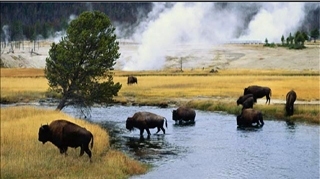|
Valley Township
Location
Third Row from north boundary of the
county, fifth township from west
Schneider township to north, Thornton to west
4 mi North & 5 mi east of Kearney to the southwest corner
East edge is 2 mi north of Gibbon
Organization
1883 when state law was passed
Two petitions in archives
No info on name
Geography
Watershed divide runs east-west about 1 ½
to 2 miles from north line.
Drainage to north goes to South Loup
River,
Drainage to south goes to Wood River
All prairie, of course, when first settled
March 25, 1905 HUB
Large prairie
fire in Valley Township caused damage on 6 farms and burned one
schoolhouse.
High winds and dry grass made fighting the fire difficult. [March winds]
Tilled land, esp. in southwest quarter of the township lot of center
pivots
More grassland in rolling hills of northeast
Cemeteries
None
Churches
Methodist
A schoolhouse was built in 1880 in
which Methodist church services and Sabbath School classes were also
held until a church could be constructed
HUB Oct 9, 1899 - Methodist
church was located in Section 20 [in upper Buckeye Valley]
United Brethren
Organized in Buckeye Valley in 1884
[south of Methodist]
Erected a church building also.
Disbanded in mid-1920s
Towns/communities
Butler [mid 1890s 1920s]
1895 map of Nebraska shows Butler
See also Buffalo Tales articles
"RECOLLECTIONS OF BUCKEYE VALLEY SCHOOL" by Ruth Gitchel Anderson and
"BUCKEYE VALLEY AND THE HAMLET OF BUTLER" by Laura Vohland Brady
Consisted of
3 homes about 1916
Methodist and United Brethren
churches
A blacksmith shop (Henry Vohland)
A grocery store
A post office located in the store.
July 31, 1884 Benjamin Gitchel first postmaster
Named for Benjamin Butler, presidential candidate on Greenback ticket
Mail came once a week, later twice a week from Gibbon
Discontinued in 1905 Rural Free Delivery
Schools
Dist. 49 Upper Buckeye
In April 1880 there was
school being taught but no school house.
Within a year a schoolhouse had been
built
There was a small pond near the schoolhouse where the children would
slide on the ice.
In 1885 the district was divided and Dist. 97 (Lower Buckeye Valley) was
formed.
Dist. 97 Lower Buckeye
Building constructed in
1886
School so crowded the children sat 3
to a seat in double desks.
In 1898 there were 60 students
enrolled [well populated area 20 or so families]
(Ann [Gitchel]s story)
There was open prairie all about the school and in spring, clumps of
wild garlic.
One recess the children took to digging and eating.
When the bell rang and the children re-assembled in the school house,
Their combined breath was overwhelming.
The teacher flung open door and windows
forbade any more gourmet foraging.
Old District 97 school house was purchased by Valley Township
Used as a township hall.
[district probably consolidated with Gibbon by then]
Grange
Buckeye Valleys claim to fame
First organized in Buffalo County in 1875
This one was one of the first
Met in schoolhouse first
In 1896 the Grange built its own
hall.
Had an agricultural fair to raise
funds
Built temporary building for fair
exhibits + big circus tent
Tore those down & built the grange
hall
Sold the hall in 1900, moved south of the Methodist church and used as a
grocery store
The grange had a revival in Nebraska about 1912.
Some fifteen years after their first hall was sold, the Butler Grange
bought the church building of the disbanded United Brethren Church for
use as a grange hall.
Homesteaders
Comparison of Gibbon Homestead colonists with
early homesteaders
No names match
Gibbon Homestead colonists must have purchased railroad land makes sense
since they came as a group on the railroad and the railroad let them use
some of their cars for a while until they got houses built
1871 2
N. W. Short
1880 - N.W., Wife Nancy, sons
Clarence, Gilbert, Frank, & Vernon
1900 - Gibbon Village
Gilbert & Mary & 3 children
Maria & sons Frank, Vernon, & Archie 18 (1881)
1910 - White Water, McPhearson Co.,
NE
Gilbert & Mary, 6 children
- North Platte, Lincoln Co
Frank & Francis & 3 children
- Omaha, Douglas Co.
Vernon & Jessie & a daughter
Archie & Maria & a daughter
M. Gray
1870 2 M. Grays in Otoe Co.
1880 No M. Gray in Buffalo Co.
Joseph, Mary, & 3 sons in Kearney
1872 3
1873 8
1874 3 Drought & grasshoppers
1875 1
18762
18784
18799
Yanney
(Aug. 17, 1903)
Archbishop of Syrian Orthodox Church from Toledo, Ohio visited Kearney.
Services were held in the West Kearney schoolhouse twice.
Archbishop met with the people and they were given permission to select a
priest.
N. E. Yanney, one of the Yanney brothers living in Valley Township, was
selected.
He was examined by the archbishop
Went east to study for several months.
Returned to Kearney and assumed control of the church.
The Syrian congregation purchased the West Kearney building
Move to 14th St. between 1st and 2nd to use as their church.
And Also:
Oct 15, 1901 - At a meeting of the County Board of Supervisors
Roe made a report on disappearance
of Mike Murphy from poor farm August 13 and subsequent search by himself and
Sheriff Funk, but nothing had been heard from him since last seen
immediately afterward when passing the Snavely place on Wood River."
|

